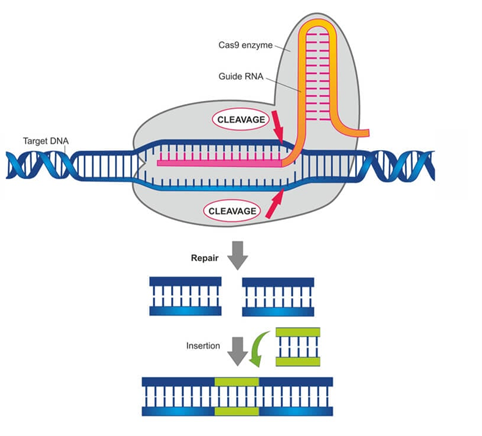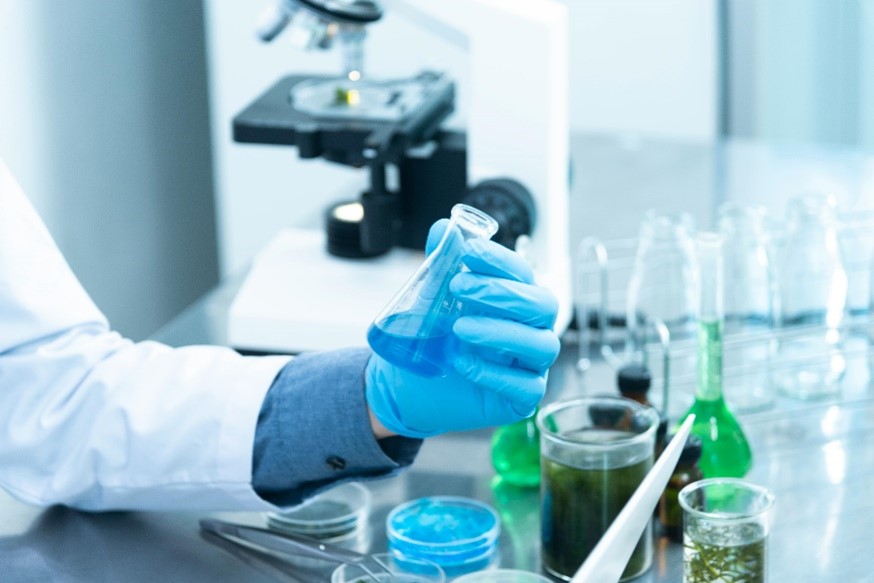By Alicia Gailliez, Business Development Manager, One Nucleus

CRISPR is short for “clustered regularly interspaced short palindromic repeats”. An article from The Jackson Laboratory on ‘What is CRISPR’ describes how the term makes reference to the repetitive pattern of DNA and “spacer” sequences in bacteria. It was discovered that bacteria transcribe these DNA elements to RNA upon viral infection. The RNA guides a nuclease (a protein that cleaves DNA) to the viral DNA to cut it, providing protection against the virus. The nucleases are named “Cas,” for “CRISPR-associated.”
This concept is nicely illustrated in the diagram below from a Labiotech article on CRISPR-Cas9: The Gene Editing Tool Changing the World.

Source: CRISPR-Cas9: The Gene Editing Tool Changing the World, Labiotech, November 3, 201, https://www.labiotech.eu/in-depth/crispr-cas9-review-gene-editing-tool/
The diagram shows the CAS/RNA complex bind to and cut the DNA molecule. DNA integrity is vital to the function of a cell, and therefore, cells have evolved mechanisms to repair damaged DNA. It also means that transcription can proceed with undamaged DNA. At this stage, researchers can intervene and change the sequence of the repaired strand, changing the function of the encoded protein. A key discovery was that using the right guide template modifies the target of the CAS protein, which is the basis for CRISPR gene editing technology.
Clearly there is significant potential for this technology when you look at the markets projected future growth. A BioSpace report states that the gene editing market is expected to witness a healthy CAGR of 15.73% from 2023 to 2032. The gene editing market includes other techniques (not only CRISPR) and is also segmented into various applications. The referenced report indicates that pharmaceuticals and biotechnology companies are expected to sustain dominance in the market. It also highlights that CRISPR technology is anticipated to drive significant growth.
 There is no doubt of the significant impact of CRISPR in treating disease. A Labiotech article on ‘Seven diseases CRISPR technology could cure’ highlights the tremendous advantage of this genome-editing technology over others for making gene editing faster, cheaper and easier than before, helping scientists to advance their research for potential new therapeutics across cancer, AIDS, cystic fibrosis, muscular dystrophy, Huntingdon’s disease, blood disorders and COVID-19. This is certainly good news for the life science sector, enabling researchers to move forward in the development of innovative medicines to improve patient outcomes and human health.
There is no doubt of the significant impact of CRISPR in treating disease. A Labiotech article on ‘Seven diseases CRISPR technology could cure’ highlights the tremendous advantage of this genome-editing technology over others for making gene editing faster, cheaper and easier than before, helping scientists to advance their research for potential new therapeutics across cancer, AIDS, cystic fibrosis, muscular dystrophy, Huntingdon’s disease, blood disorders and COVID-19. This is certainly good news for the life science sector, enabling researchers to move forward in the development of innovative medicines to improve patient outcomes and human health.
Looking beyond human health and the impact of gene editing technology is truly being felt across other sectors.
Statistics from the United Nations published in 2017 predicts that there will be an additional 2.2 billion people on the planet by 2050, highlighting the urgent need for sustainable food production solutions. CRISPR-Cas9 genome editing technology is emerging as a critical tool in addressing the challenge of food security and safety. An article titled CRISPR and Delicious in the February 2024 issue of Genetic Engineering and Biotechnology News highlights one of the most high-profile applications of CRISPR-Cas9 in the food industry: meat production. The article cites the example of Meatable, a company which has leveraged CRISPR technology to cut its production time from three weeks to just eight days, achieving a four to eight-fold improvement in production efficiency. Another promising application of CRISPR in the food industry is the creation of cultured milk that is non-allergenic and lactose-free, catering to individuals with lactose intolerance and milk allergies.
As CRISPR technology continues to evolve, it will be exciting to see the advancements and new applications that emerge in coming years. An article from Labiotech 10 Unusual Applications of CRISPR Gene Editing highlights how this technology can be used to optimise the health of people, animals and the environment, including breeding pets without genetic diseases, creating allergy-free foods, improving production of biofuels from algae, eradicating pests like malaria-spreading mosquitoes, creating more nutritious fish, and efforts towards de-extincting species like the passenger pigeon.
 From a regulatory perspective, it is encouraging to see how the UK is approaching regulation to help potential future applications of gene editing technology in agri-food innovation. The Precision Breeding Act provides a clear regulatory framework for the development and use of precision-bred, as opposed to genetically modified, plants and animals. The framework also aims to balance innovation and safety. The hope is that this will help to reduce hurdles and encourage development in CRISPR applications in agricultural biotechnology. This is significant given the interconnectedness of human and plant health. A good example of this is a tomato has been edited using CRISPR technology to make it a rich source of vitamin D.
From a regulatory perspective, it is encouraging to see how the UK is approaching regulation to help potential future applications of gene editing technology in agri-food innovation. The Precision Breeding Act provides a clear regulatory framework for the development and use of precision-bred, as opposed to genetically modified, plants and animals. The framework also aims to balance innovation and safety. The hope is that this will help to reduce hurdles and encourage development in CRISPR applications in agricultural biotechnology. This is significant given the interconnectedness of human and plant health. A good example of this is a tomato has been edited using CRISPR technology to make it a rich source of vitamin D.
An important distinction to make is that precision bred plants and animals will be treated differently to genetically-modified-organisms (GMOs), for which stricter regulations will remain in place. The classification of CRISPR-modified products as GMOs varies by region, affecting regulatory frameworks and market acceptance. Regardless, the potential of CRISPR technology to drive advancements in human health through the production of more nutritious crops is immense.
 The above example is a testament to the power of cross-disciplinary collaboration. Just as the Medici Effect describes the spark of ideas and innovation at the intersection of different disciplines, combining insights from experts in molecular biology, genomics, agriculture, and nutrition is helping to drive production of healthier food. Another perfect example of this is the application of CRISPR as a tool to address climate change. A recent research initiative at the Innovative Genomics Institute (IGI), funded by an $11 million commitment from the Chan Zuckerberg Initiative (CZI), is leveraging CRISPR genome editing to enhance the carbon capture and storage capabilities of plants and soil microbes.
The above example is a testament to the power of cross-disciplinary collaboration. Just as the Medici Effect describes the spark of ideas and innovation at the intersection of different disciplines, combining insights from experts in molecular biology, genomics, agriculture, and nutrition is helping to drive production of healthier food. Another perfect example of this is the application of CRISPR as a tool to address climate change. A recent research initiative at the Innovative Genomics Institute (IGI), funded by an $11 million commitment from the Chan Zuckerberg Initiative (CZI), is leveraging CRISPR genome editing to enhance the carbon capture and storage capabilities of plants and soil microbes.
One Nucleus plays an essential role in facilitating these interactions by providing an environment for networking and knowledge exchange and stimulating discussion. A prime example of this is the upcoming event ‘One Region One Health’ on 16 September at Babraham Research Campus. This event will bring together diverse stakeholders to discuss collaborative strategies to achieve the WHO One Health goals, described as an integrated, unifying approach to balance and optimise the health of people, animals and the environment.
There will be a chance to hear case studies from those operating in different sectors on tools and technologies that have potential to offer solutions to current societal challenges, from treating disease to improving food nutrition and sustainability, with a focus on the regional stakeholders that exist at close quarters.
 Part of the discussion will also focus on the practical steps of bringing together diverse expertise, including strategies for commercialisation of solutions, addressing global inequalities, attracting investment, and IP protection; the latter will be led by event sponsors Appleyard Lees, who will discuss the challenges that can arise in IP ownership with multiple stakeholders, for example.
Part of the discussion will also focus on the practical steps of bringing together diverse expertise, including strategies for commercialisation of solutions, addressing global inequalities, attracting investment, and IP protection; the latter will be led by event sponsors Appleyard Lees, who will discuss the challenges that can arise in IP ownership with multiple stakeholders, for example.
Don’t miss this opportunity to connect with experts from diverse fields that could lead to your own potential collaborations and contribute to the advancement of the One Health approach by registering today. Hurry, as places are limited!